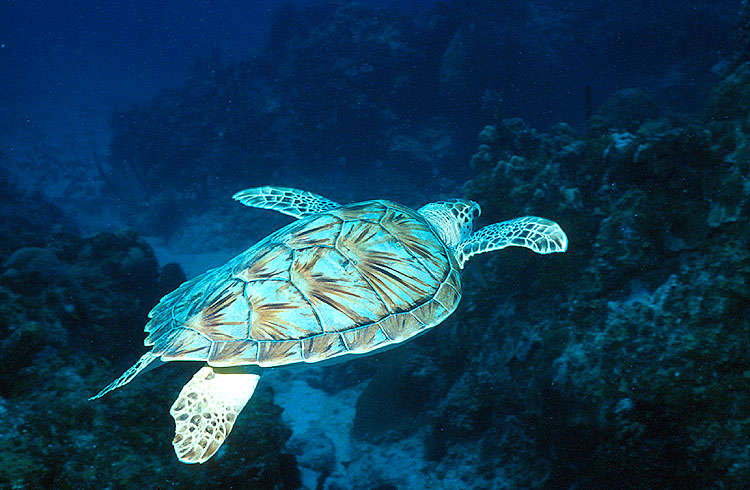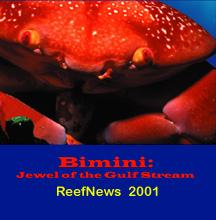


The ReefNews staff encountered this magnificent animal about 45 feet underwater near Rockwell Reef off the west coast of Bimini. We were swimming near the tops of the coral heads when we saw this turtle. The turtle was lurking between two coral heads near the sandy bottom. (You can see a gully between the coral heads that is filled with sand in the distance, just below this turtle.) When it saw us, it swam up to meet us. It swam around to each diver for a close look, and then it swam off into the distance.
This animal is a Hawksbill Turtle. The Hawksbill Turtle gets its name from its hawk-like beak. That is, the top of its beak (also called its bill) overhangs the bottom of its beak. This makes its beak look like the beak of a hawk. There are several other features that make this turtle easy to identify. Notice the edge of the back of its shell. Its shell has a rough border, which is a characteristic of Hawksbill Turtles. Also, notice that this turtle's shell is brightly colored and very beautiful. This also is a characteristic of Hawksbill Turtles.
Hawksbill Turtles are reptiles. These turtles breathe air. The turtle will swim to the surface to breathe, breaking the surface with a little splash that makes them easy to see on calm days. After breathing, the turtle will hold its breath as it dives to hunt for sponges. The turtle may stay under water for several minutes before needing to return to the surface to breathe again. Female turtles crawl out of the sea and onto sandy beaches to make nests and lay eggs. The mother turtle digs a hole in the sand, lays her eggs in the hole, covers the eggs with sand, and then leaves the nest and returns to the ocean.
Like other sea turtles, the Hawksbill Turtle is an endangered species. Hunters have killed Hawksbill Turtles for their shells and have collected their eggs from nests on beaches until there are not many left. Sometimes boats run into turtles when the turtles come to the surface to breathe. A new problem facing sea turtles is that people have built buildings near the beaches where turtles come ashore to lay their eggs, which may scare the turtles away and prevent them from laying their eggs. Also, the buildings may confuse the babies when they hatch because the lights from the buildings may hide the light from the sunrise (which is how the baby turtles know which direction to crawl to find the sea). There are many threats to sea turtles. We must learn about these threats to help protect the few turtles that are left, so there will always be sea turtles in our oceans.
Compare this Hawksbill Turtle to the Loggerhead Turtles found on two other ReefNews web pages. Compare this Hawksbill Turtle with the giant Loggerhead Turtle and small Loggerhead Turtle. Can you tell that the colors of the turtles' shells are different? Can you see that the back edge of the Loggerhead Turtles' shells is smooth while the back edge of the Hawksbill Turtle's shell is rough?
 Learn more about the Coral Reefs of Bimini on the 2001 ReefNews CD-ROM
Learn more about the Coral Reefs of Bimini on the 2001 ReefNews CD-ROM
Bimini: Jewel of the Gulf Stream
Tessa Dowell took this picture using a Nikonos V with 28mm lens and SB105 strobe. This photo was taken during the ReefNews research expedition to Bimini, June 1999.